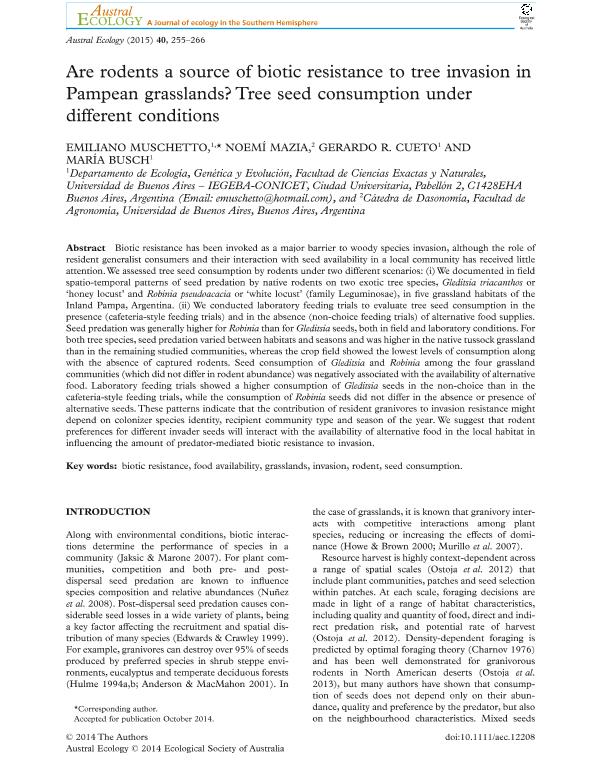Mostrar el registro sencillo del ítem
dc.contributor.author
Muschetto, Emiliano

dc.contributor.author
Mazía, Cristina Noemí

dc.contributor.author
Cueto, Gerardo Ruben

dc.contributor.author
Busch, Maria

dc.date.available
2017-07-05T20:43:06Z
dc.date.issued
2015-05
dc.identifier.citation
Muschetto, Emiliano; Mazía, Cristina Noemí; Cueto, Gerardo Ruben; Busch, Maria; Are rodents a source of biotic resistance to tree invasion in Pampean grasslands? Tree seed consumption under different conditions; Wiley; Austral Ecology; 40; 3; 5-2015; 255-266
dc.identifier.issn
1442-9985
dc.identifier.uri
http://hdl.handle.net/11336/19698
dc.description.abstract
Biotic resistance has been invoked as a major barrier to woody species invasion, although the role of resident generalist consumers and their interaction with seed availability in a local community has received little attention.We assessed tree seed consumption by rodents under two different scenarios: (i) We documented in field spatio-temporal patterns of seed predation by native rodents on two exotic tree species, Gleditsia triacanthos or ‘honey locust’ and Robinia pseudoacacia or ‘white locust’ (family Leguminosae), in five grassland habitats of the Inland Pampa, Argentina. (ii) We conducted laboratory feeding trials to evaluate tree seed consumption in the presence (cafeteria-style feeding trials) and in the absence (non-choice feeding trials) of alternative food supplies. Seed predation was generally higher for Robinia than for Gleditsia seeds, both in field and laboratory conditions. For both tree species, seed predation varied between habitats and seasons and was higher in the native tussock grassland than in the remaining studied communities, whereas the crop field showed the lowest levels of consumption along with the absence of captured rodents. Seed consumption of Gleditsia and Robinia among the four grassland communities (which did not differ in rodent abundance) was negatively associated with the availability of alternative food. Laboratory feeding trials showed a higher consumption of Gleditsia seeds in the non-choice than in the cafeteria-style feeding trials, while the consumption of Robinia seeds did not differ in the absence or presence of alternative seeds. These patterns indicate that the contribution of resident granivores to invasion resistance might depend on colonizer species identity, recipient community type and season of the year. We suggest that rodent preferences for different invader seeds will interact with the availability of alternative food in the local habitat in influencing the amount of predator-mediated biotic resistance to invasion.
dc.format
application/pdf
dc.language.iso
eng
dc.publisher
Wiley

dc.rights
info:eu-repo/semantics/openAccess
dc.rights.uri
https://creativecommons.org/licenses/by-nc-sa/2.5/ar/
dc.subject
Biotic Resistance
dc.subject
Food Availability
dc.subject
Grasslands
dc.subject
Invasion
dc.subject
Rodents
dc.subject
Seed Consumption
dc.subject.classification
Ecología

dc.subject.classification
Ciencias Biológicas

dc.subject.classification
CIENCIAS NATURALES Y EXACTAS

dc.title
Are rodents a source of biotic resistance to tree invasion in Pampean grasslands? Tree seed consumption under different conditions
dc.type
info:eu-repo/semantics/article
dc.type
info:ar-repo/semantics/artículo
dc.type
info:eu-repo/semantics/publishedVersion
dc.date.updated
2017-07-05T15:03:28Z
dc.journal.volume
40
dc.journal.number
3
dc.journal.pagination
255-266
dc.journal.pais
Estados Unidos

dc.journal.ciudad
Hoboken
dc.description.fil
Fil: Muschetto, Emiliano. Consejo Nacional de Investigaciones Científicas y Técnicas. Oficina de Coordinación Administrativa Ciudad Universitaria. Instituto de Ecología, Genética y Evolución de Buenos Aires. Universidad de Buenos Aires. Facultad de Ciencias Exactas y Naturales. Instituto de Ecología, Genética y Evolución de Buenos Aires; Argentina
dc.description.fil
Fil: Mazía, Cristina Noemí. Universidad de Buenos Aires. Facultad de Agronomia. Departamento de Producción Vegetal. Cátedra de Dasonomia; Argentina
dc.description.fil
Fil: Cueto, Gerardo Ruben. Consejo Nacional de Investigaciones Científicas y Técnicas. Oficina de Coordinación Administrativa Ciudad Universitaria. Instituto de Ecología, Genética y Evolución de Buenos Aires. Universidad de Buenos Aires. Facultad de Ciencias Exactas y Naturales. Instituto de Ecología, Genética y Evolución de Buenos Aires; Argentina
dc.description.fil
Fil: Busch, Maria. Consejo Nacional de Investigaciones Científicas y Técnicas. Oficina de Coordinación Administrativa Ciudad Universitaria. Instituto de Ecología, Genética y Evolución de Buenos Aires. Universidad de Buenos Aires. Facultad de Ciencias Exactas y Naturales. Instituto de Ecología, Genética y Evolución de Buenos Aires; Argentina
dc.journal.title
Austral Ecology

dc.relation.alternativeid
info:eu-repo/semantics/altIdentifier/doi/http://dx.doi.org/10.1111/aec.12208
dc.relation.alternativeid
info:eu-repo/semantics/altIdentifier/url/http://onlinelibrary.wiley.com/doi/10.1111/aec.12208/abstract
Archivos asociados
